Retrospective of technology startups. Z3 - the first relay computer

I decided to start a retrospective of technology startups with an amazing history of creating the first
Z3 was conceived and created by young brilliant engineer Conradom Tsuze at the wrong time for this. He laid the foundation for the first company in continental Europe to develop and sell computers on a commercial basis.
What is all this for?
В первом стартапе я принял участие на следующий год после окончания института, хотя тогда мы ещё не знали этого модного слова. С тех пор, я в том или ином роде, имел отношение к немалому их количеству. Большинство просуществовали недолго, но случались и успешные. Попытки анализа показали что удачная стратегия стартапа меняется в зависимости от общественно-политической ситуации, в которой он зарождается. Чтобы выбрать лучшую стратегию для сегодняшнего, не будет лишним разобраться каким образом достигался успех в прошлом, а затем попытаться обобщить информацию и выбрать лучший вариант развития на сегодняшний день. Начать я решил с ретроспективы нескольких удачных технологических стартапов, которые показались мне наиболее характерными для своего времени.
Germany, the second half of the 30s of the last century. Adolf Hitler has been in power for several years. The country is working on a computer. Development continues despite the fact that the first model is not too successful. With each new model, the device is becoming more perfect. Z1, Z2, finally, in May 1941, the first workable version appears - Z3. In 1943, the Allies managed to destroy the entire model range of the Z1 - Z3, but by that time work was already underway to create a much more advanced model - the Z4. The assembly is transferred to secret passages of mines, in which the development of a top-secret rocket program is underway. No matter what, the work on the Z4 is possible to finish literally in the last days of the war and secretly take the computer to Switzerland ...
It sounds very ominous. But stamps are very far from the truth. Let us try to clarify how the first electromechanical computer was actually created and what it was like.
Of course, the military could not do without them, they provided some assistance, but in general, the development was carried out rather in spite of, and not thanks to, people in uniform.
Girls, as the engine of progress
Konrad Ernst Oto Tsuze Konrad Ernst Otto Zuse in spite of the solidly sounding full name was born in the family of a small postal official, in 1910, in Berlin. From childhood, the boy was drawn to the design. While still at school, he assembled a working model of a coin-changing machine and was enthusiastically engaged in urbanism — creating a city project for 37 million inhabitants. Passion for business and large numbers in it originated even then. Not surprisingly, becoming a young man, he entered the Berlin Technical University on a specialty of civil engineering. The learning process was not as interesting as it seemed in childhood. Especially “got” matt. It was necessary for hours to pore over monotonous and extremely tedious calculations, while peers spent time with attractive girls ...

It was then, at the junior courses, he had the idea to automate the calculations. At first, he dreamed of creating a perfect calculator, but in the last year he wanted more.
In 1935, at the end of the university, Konrad managed to get a job as an engineer at the Henkel Aircraft Factory. It would seem that in those years could be more interesting than aviation? But in practice, boring calculations had to be given even more time and in his free time the young man begins to think through a detailed plan for a device that can facilitate this process.
Representation of numbers
Thinking about the simplest way to implement computations, Konrad came up with the idea of performing operations on binary numbers. At that time, there were suitable and accessible components that provide two stable states - telephone relays. He decided to take them as a basis and thought out ways to implement the simplest arithmetic operations with their help.
Next, it was necessary to determine how to enter, represent and store numbers. Simply put, organize “memory” and access to it. Most of the mechanical calculators that existed at the time provided data input using a system of gears that had 10 positions.

More advanced read coded numbers from punched cards and could have up to 20 counters. Entering new numbers was carried out by adding punched cards.
In order to expand the range of calculations Conrad decided to carry out operations on floating-point numbers in binary representation. He decided to create memory registers consisting of 22 binary bits. In each of them, 14 bits were allocated for the mantissa, 7 for the degree and 1 for the sign.
However, another problem arose. Yes, it is much easier for a computer to operate with binary numbers than with decimal ones, but they are perceived with great difficulty by a person, especially in floating point representation.
To simplify the work of operators, it was decided to enter the figures of the source data in decimal format, then automatically convert to binary and load into memory. With the result of the reverse process.
Memory system
Solving the problem of the physical implementation of memory was not easy. Electronic relays took up too much space and consumed a lot of energy. In addition, the cheapest of them cost more than two brands, which is very sensitive hit on the pocket. After a long search for a suitable solution, Konrad came up with an original alternative - a mechanical device based on metal pins. A small pin could be on the left or right of the tip, remembering zero or one. Installation and extraction of numbers was carried out using plates. Separate memory modules could be assembled into a matrix.

A fragment of the “memory” device - all that remained of the first model after the bombing,
Konrad called it the “Mechanical Relay Memory” and in 1936 received two patents for it. According to them, such memory could be expanded to store a thousand words. An alternative implementation would require 40,000 relays. Such a memory could in principle store any type of data, so in the application for an invention he called it “combinational”
CPU
Designing the computing part of the device was the hardest. Konrad has long experimented with various implementations. Among the prototypes there were even devices with four stable states, but in the end, it was still possible to reduce everything to binary logic. It took some time to decide on what basis to build a computer. Use telephone relays or an original mechanical device. According to his estimations, at least a thousand relays were required to build a calculator. Assessing the cost, size and energy consumed by them, Konrad inclined to the mechanical version, which at that time seemed to him much simpler to implement.
If you are so smart, then why not use lamps?
Collecting such a complex mechanical device alone was not very easy, so Konrad decided to bring his close friend Helmut Schreier to the project Helmul Schreyer. At that time, he graduated from the university as a radio engineer and helped the department to develop electromagnetic relays. His skills came in handy at the right time!

Young engineers. Conrad on the left, Helmut on the right
Helmut liked the idea very much, but he wondered: “Why not use electronic lamps as switching elements, which can provide switching speeds tens of thousands of times greater than relays?” At first Konrad thought it was a joke, but after listening to the arguments of his friend and poraskinuv brains found the idea very interesting. The basis of memory, the tube trigger was invented back in 1918, but in 1936 there was still to be found circuit solutions for calculating arithmetic operations.
 Acquaintances with whom they shared the idea were divided into two camps - one idea seemed ingenious, the others declared its complete rejection. What was bad was that the second was mainly specialists who had experience working with vacuum tubes. Their main argument was the low reliability of the lamps. They believed that a device consisting of more than 2000 lamps would constantly fail. Other unsolvable problems at that stage were the high cost and scarcity of suitable lamps. No matter how stunning the possibilities were, such a decision did not promise technically, the friends were not able to carry it out on their own, but they didn’t want to completely refuse it. Therefore, they agreed that they would start building a mechanical version, and Helmut would simultaneously look for circuit solutions for the nodes, performing elementary mathematical operations. In the future, having a prototype of a working device on mechanical relays will not be difficult to replace the actuators with lamps.
Acquaintances with whom they shared the idea were divided into two camps - one idea seemed ingenious, the others declared its complete rejection. What was bad was that the second was mainly specialists who had experience working with vacuum tubes. Their main argument was the low reliability of the lamps. They believed that a device consisting of more than 2000 lamps would constantly fail. Other unsolvable problems at that stage were the high cost and scarcity of suitable lamps. No matter how stunning the possibilities were, such a decision did not promise technically, the friends were not able to carry it out on their own, but they didn’t want to completely refuse it. Therefore, they agreed that they would start building a mechanical version, and Helmut would simultaneously look for circuit solutions for the nodes, performing elementary mathematical operations. In the future, having a prototype of a working device on mechanical relays will not be difficult to replace the actuators with lamps.To the case, finally!
The fundamental principles that must meet the conceived device:
- computational operations are carried out in the binary system;
- the machine operates with floating point numbers;
- memory and computer were allocated in different blocks;
- program control computing
Today they seem obvious, but not so 80 years ago. Most of the first electromechanical computers, which appeared a few years later, operated on fixed-point decimal numbers, which significantly limited the range of calculations, even though their capacity was large.
Having worked as an engineer for just a year, Conrad goes to half-time in 1936, and devotes all his free time to creating a programmable machine. The converted living room of the parental home was turned into an assembly shop.
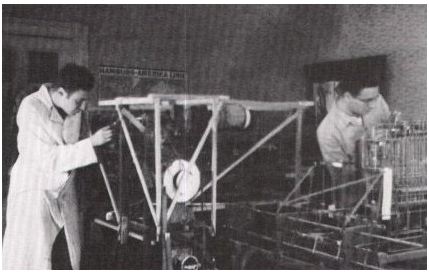
Helmut provided him with invaluable assistance during assembly work. Initially, the friends planned to assemble an experimental model of a mechanical calculator in just six weeks, but in practice,
Necessity on invention is cunning
Two years of hard work passed before the car finally began to show signs of life. Today it is hard to believe that two young people gathered this monster in their spare time, using their modest means. Here it is impossible not to recall the Russian proverb: “Needle for invention is cunning”.
The machine was located on four desks that were moved together, which barely held its weight - more than five hundred kilograms! It consisted of almost 20,000 items.
Unlike similar electromechanical counting machines developed during this time period, Z1 performed calculations on binary numbers. Moreover, the numbers were entered in the decimal system with a floating point, and already inside the machine they were converted to 22 bit binary using a mechanical decoder. Data entry was carried out using the keyboard, which played the role of a creatively modified typewriter. After conversion, input values were recorded in a mechanical internal memory. The amount of computer memory was 64 words. The heart of the car was a “clock generator”, which was driven by an electric motor with a power of about 1 kW, borrowed from a vacuum cleaner. The operating frequency of the generator was 1 Hz, and the speed was stabilized by an ingenious mechanism.

The machine worked like this: At first, the data was decrypted and loaded into memory. Then the program began to run. It was read from paper punched tape and as it was being read it was being executed. With this approach, the program was supposed to be extremely linear, no branches were envisaged. In conclusion, the calculated value was translated into decimal form and displayed on the lamp board.
At the urgent request of the habrouser ASTAPP , which

Victory, but not Pyrrhic?
The machine, assembled in absolutely “unhygienic” conditions, worked, but to say that it was not distinguished by the stability of the calculations — to say nothing.
Konrad originally planned it as a model to demonstrate the possibilities, but even for this, she was not very suitable. He was convinced of this trying to “raise” the first investment. It was possible to carry out even twice successive calculations on it far from each time. After the next failure, I often had to reconfigure. Particularly bad was the situation with the “processor”, the required accuracy of the manufacture of mechanical elements of which at home was unrealistic. It was extremely difficult to interest such a sample of investors, but Conrad did not give up hope.
After a long search, he succeeded in obtaining an audience with Kurt Pannke, the retired owner of the production of mechanical calculators - who took him rather from boredom. Kurt was in full confidence that the computers had reached the limit of their perfection, and in the near future it would not be possible to come up with something new in the field of computing automation. However, he agreed to visit the workshop and take a look at the Z1. And then Conrad finally smiled luck. During Dr. Pannke’s visit, the machine managed to perform several calculations in a row without a single failure. The doctor was so impressed with her work that he agreed to provide seven thousand Reichsmarks for improving the apparatus.
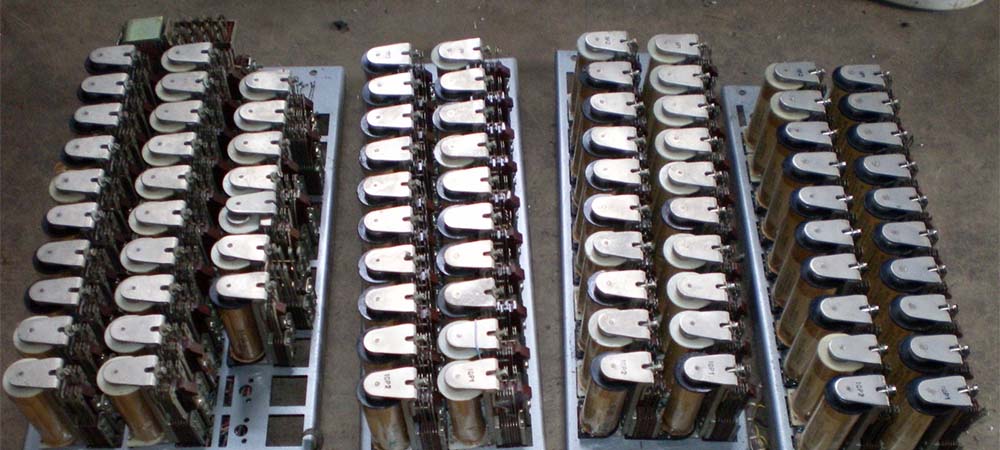
Soon, Konrad was again smiled by good luck - his friends helped him to get the telephone equipment from which he extracted about 800 used relays for a pittance. More than half of them seemed quite workable
Z2 - two steps back, one forward
To demonstrate to more serious potential investors, it was necessary to significantly increase the reliability of calculations. Konrad decides to kill two birds with one stone - to create a simplified, but stable working model, using a relay calculator. Friends helped him to develop a circuit of elementary computational cells based on the relay, and he again set to work.
I had to completely dismantle the calculator and half of the memory, reducing it to 16 words. Memory and decoders still remained mechanical, but their design was greatly simplified. Malfunctions in their work began to occur much less frequently. From floating point calculations it was also decided to temporarily give up. In the new model, the calculator operated with 16-bit numbers and a fixed point. To increase reliability, the reader of the programs was improved - instead of paper, Conrad used a 35 mm film. The engine power from the vacuum cleaner was enough for the simplified car to work three times faster than the first option - the clock frequency increased to three hertz. Z2 was able to perform 8 different instructions.
Z3. War as an engine of progress?

Z2 earned in 1939. The inspired Conrad begins the creation of a third model, which is already conceived as a tool for real computing. However, life began to make significant changes to his plans. Germany is preparing to enter into a large-scale war and it needs engineers to develop aircraft, the top military officials did not think about computers. Konrad changed civilian clothes to a military uniform, but at least he was not sent to the front. He still devotes all his free time to creating a third model, but despite the fact that he is actively helped by friends, it becomes more and more difficult to combine development with military service. The money received from a business angel is running out, the search for the necessary configuration is becoming more and more difficult - too many resources are consumed by preparing for war and even with the means it becomes more difficult to buy the necessary components. Under these conditions, there was nothing left but to look for support from the military.
In 1940, Conrad seeks to demonstrate his Z2 model at the Research Institute of Aerodynamics. It is impossible to say that he created a furore there, but his calculator really liked the project manager for the creation of guided bombs, Professor Teuhmann. The professor is seeking to connect Conrad to his project to automate calculations in the field of aerodynamic research. In parallel, Conrad received the funding and organizational support needed to complete work on the Z3 computer. In the same year he organized the company Zuse Apparatebau for the production of programmable machines.
In addition to the money, Conrad received premises and assistants, thanks to which the process of creating the car was significantly accelerated and the Z3 was put into operation in the spring of 1941. Its architecture strongly resembled the Z1 model, but it believed it was five times faster, and most importantly it worked so reliably that it could be used for real computations, in particular, the calculation of the swept wing shape.
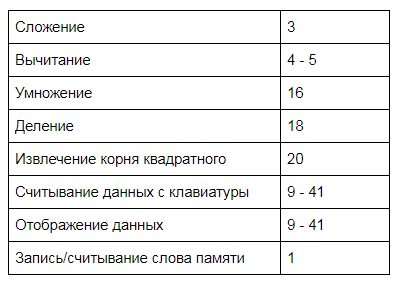
The number of cycles spent on operation
Z3 consisted of 2400 relays. 600 of them worked in the computing module, the rest played the role of a memory of 64 words in size. The protection of the result from overflow was introduced, the output of the calculation results was made on punched tape
Z3 was the first computing device assembled entirely on electromagnetic relays. However, disputes over the title of the first computerstill underway. The fact is that although Z3 worked according to the program, it did not support either cycles or conditional transitions. Launched in the summer of 1944, the MARK-I Harvard had the possibility of branching, although it was very limited. At the same time, some operations, such as data entry, were carried out mechanically.
Z4 war and miraculous salvation
Having completed work on the Z3, Konrad heads in 1941 already in the secret project of creating the next generation of computer - Z4.
In parallel, Zuse develops specialized calculators and launches the S1 model in 1942. Her follower S2, earned later, perhaps, is the world's first industrial computer. He automatically collected data from several dozen sensors and performed complex calculations on them. Used to build aerodynamic models.
 Beginning in 1943, Berlin began to be bombed by the Allies. Development has become complicated by the fact that constantly had to transport equipment from place to place. Technical specialists and assistants were drafted into the army and thrown to the front. As a result, the next air raid Z3 and all that remained of the Z2 and Z1 by the time it was destroyed. In the end, a few months before the end of the war, Conrad and a couple of assistants were put in the most reliable place - the bunker in the abandoned mines, where the super-secret German rocket program developed.
Beginning in 1943, Berlin began to be bombed by the Allies. Development has become complicated by the fact that constantly had to transport equipment from place to place. Technical specialists and assistants were drafted into the army and thrown to the front. As a result, the next air raid Z3 and all that remained of the Z2 and Z1 by the time it was destroyed. In the end, a few months before the end of the war, Conrad and a couple of assistants were put in the most reliable place - the bunker in the abandoned mines, where the super-secret German rocket program developed. The conditions for working there were terrible, but he was even more struck by the treatment of prisoners of war who played the role of unskilled labor.
In the last days of the war, taking advantage of the confusion, Conrad, along with his pregnant wife, flees from Berlin on a horse-drawn carriage. Under a pile of belongings were hidden boxes with fragments of an unfinished model Z4.

So he finds himself in a small Bavarian village of Hinterstein, and his unfinished brainchild in the far corner of the barn, hidden behind a pile of wood. These were very difficult times. At first, Konrad earned his bread by making wooden commemorative engravings and selling them to American soldiers.
A small remark. Initially, Conrad's computing devices were called V1, V2, V3, V4. V comes from Versuchsmodell - an experimental model. But just such names had models of rockets being developed in mines where he worked a little. Immediately after the war, he renamed the entire line, starting from the first letter of his last name. Both moral and ethical considerations and business strategy played a role in this. Konrad did not want his children to be reminded of the war.
Z4 as a phoenix, risen from the ashes
Gradually, life began to improve, but for several years Germany was forbidden to engage in any of their own development. Fortunately, we managed to reestablish contacts with friends who had time to move abroad.
In 1946, Zuse managed to attract venture capital from the Swiss Higher Technical School and IBM. He manages to move to Switzerland, organized the Zuse-Ingenieurbüro Hopferau , a commercial computer manufacturing company Zuse Engineering Service in Hopfera, and continue working on the Z4.
 By that time, the Z4 was no longer the most advanced devices. Appeared the first American lamp computers that worked significantly faster. The Z4 was just an order of magnitude faster than its predecessor, and its structure was very similar to it. However, losing in performance, the Z4 had a serious advantage - it was simpler and much more reliable and turned out to be the only electronic counting machine in the territory of continental Europe, suitable for replication and commercial use at that difficult time.
By that time, the Z4 was no longer the most advanced devices. Appeared the first American lamp computers that worked significantly faster. The Z4 was just an order of magnitude faster than its predecessor, and its structure was very similar to it. However, losing in performance, the Z4 had a serious advantage - it was simpler and much more reliable and turned out to be the only electronic counting machine in the territory of continental Europe, suitable for replication and commercial use at that difficult time.  In 1948, Conrad shows his car to Professor Eduard Stiefel Eduard Stiefelfrom the company ETH-Zürich, who examined the car, found it quite suitable for scientific calculations. Stiefel was struck by the ease of programming, good calculation accuracy and correct exception handling. Z4 operated with words from 32 discharges, and not 24 as at its predecessor.
In 1948, Conrad shows his car to Professor Eduard Stiefel Eduard Stiefelfrom the company ETH-Zürich, who examined the car, found it quite suitable for scientific calculations. Stiefel was struck by the ease of programming, good calculation accuracy and correct exception handling. Z4 operated with words from 32 discharges, and not 24 as at its predecessor. Konrad received 100,000 dochmarks for finalizing the computer to a commercial version that suits the company ETH. It was a large sum, while in Germany the average salary was 160 marks.
 The creation of an improved model of the Z4 took 60,000 Deutschmarks, and the rest he invested in the development of his own business. Inspired by success, Konrad founded his own company Zuse KGand began developing an improved version of the Z4. At the request of EHT, conditional transitions were added, instructions for printing results on a Mercedes typewriter or punched tape, recording results on punched tape, and other improvements. The improved model was released in 1950 and was able to organize cycles and branches. The program was still read from the punched tape and was immediately executed in steps, but the possibility of skipping the next instruction and switching to another reader of punched tape, which were installed on the machine, was added. This made it possible to run conditional jumps and even the execution of subroutines if the tape on the reader was looped back. The clock speed of the computer has been increased to 40 Hz. The memory, as in the first model, was assembled on the “mechanical relays” previously patented by Conrad.
The creation of an improved model of the Z4 took 60,000 Deutschmarks, and the rest he invested in the development of his own business. Inspired by success, Konrad founded his own company Zuse KGand began developing an improved version of the Z4. At the request of EHT, conditional transitions were added, instructions for printing results on a Mercedes typewriter or punched tape, recording results on punched tape, and other improvements. The improved model was released in 1950 and was able to organize cycles and branches. The program was still read from the punched tape and was immediately executed in steps, but the possibility of skipping the next instruction and switching to another reader of punched tape, which were installed on the machine, was added. This made it possible to run conditional jumps and even the execution of subroutines if the tape on the reader was looped back. The clock speed of the computer has been increased to 40 Hz. The memory, as in the first model, was assembled on the “mechanical relays” previously patented by Conrad.Konrad created a successful business, several dozens of computers of the Z4 series were sold and put into operation. They were so reliable that they were left working for the night without supervision. The company developed dynamically, new, sometimes revolutionary models appeared, which made a great contribution to the development of computer technologies. But that's another story.
Went down in history
Germans value their history. All three options
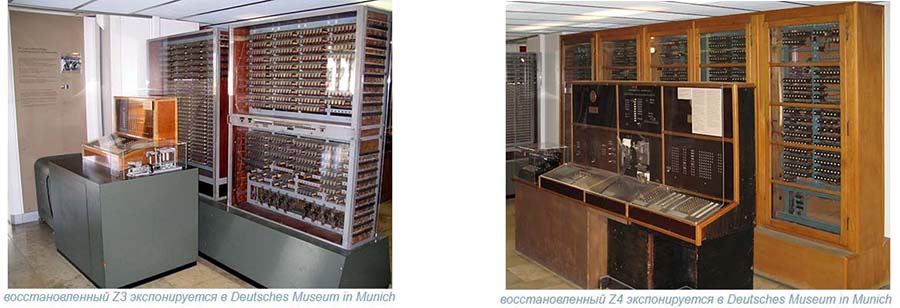

In the Soviet Union there were no less achievements in the field of computer development. We began to develop this industry with a noticeable lag, but quickly caught up with “Western partners” and at a certain stage had breakthrough developments and just models with interesting solutions and a history of creation. However, the only collection of substantial dimensions known to me, devoted to the old computer technology, is possessed by the Polytechnical Museum in Moscow. It seems to me unfair that a country devoting so much space to “spiritual claps” is in fact indifferent to the history of its achievements in science and technology. The USSR did not live in a single war!
Today there are a lot of billionaires in our country, including those “not using them, but developing the Internet”, but enthusiasts who, with great difficulty and for their money, have collected a mini-computer collection in St. Petersburg cannot find a suitable room for its exposition, what can we say about recreating destroyed copies! Something is wrong in our kingdom.
From the author. How the article was written
Изначально я задумал обзор развития компьютеров первого поколения. В ходе сбора материала не мог обойти линейку электромеханических компьютеров Z1 — Z4, рождённых в Германии. Бегло познакомившись с ней обнаружил, что история их создания рвёт многие шаблоны моего мозга. По сегодняшней терминологии это стартап, реализованный гениальным инженером в совершенно чудовищных условиях нарастающего тоталитаризма, а затем и ужасе второй мировой войны. Не смотря на внешние обстоятельства, он упорно шёл к достижению цели более десяти лет и смог не только закончить свою разработку, но и рискуя своей жизнью и жизнью беременной жены вывезти в подводе, в 20 коробках результаты многолетней работы из разрушенного Берлина. Найти в себе силы организовать фирму по производству компьютеров в условиях послевоенной разрухи, царящей в континентальной Европе.
Погружаясь в тему глубже, я столкнулся с большим количеством ляпов и противоречий в русскоязычных материалах. После вот этого шедевра моё терпение лопнуло:
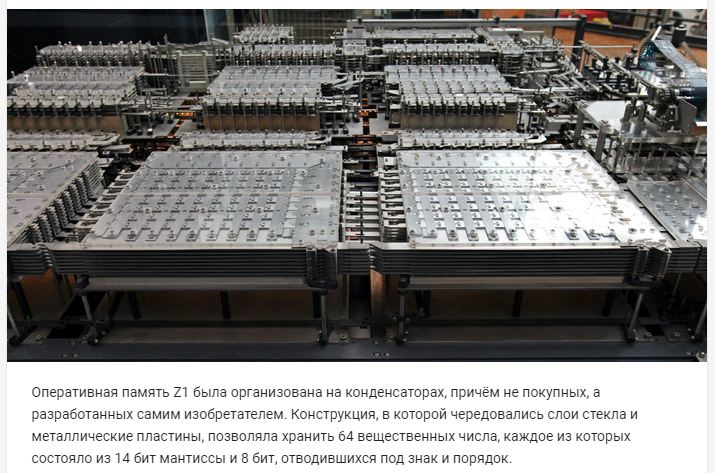
кстати, на этой картинке отлично можно рассмотреть устройство механической памяти Z1, видны «пластины» и «штыри», а также как она собирается в пакеты
Горе переводчик увидев слово capacity решил, что речь идёт не о ёмкостичитай размере памяти, а о том, что она изготовлена на основе конденсаторов и творчески додумал историю про стеклянные и металлические пластины. Затем этот очевидный ляп прокопипастили во многие другие русскоязычные статьи. После этого, я перешёл на англоязычные источники, но и в них встречались противоречия и недоговорки. Я очень старался восстановить хронологию событий, но мог немного «накосячить» в самых тёмных страницах этой истории, которые касаются последних месяцев войны.
Погружаясь в тему глубже, я столкнулся с большим количеством ляпов и противоречий в русскоязычных материалах. После вот этого шедевра моё терпение лопнуло:

кстати, на этой картинке отлично можно рассмотреть устройство механической памяти Z1, видны «пластины» и «штыри», а также как она собирается в пакеты
Горе переводчик увидев слово capacity решил, что речь идёт не о ёмкости
Who managed to finish reading the article to the end, please take part in the survey, the results of which are very interesting to me. The main topic is whether a totalitarian state is capable of not only making a breakthrough in a certain direction of science and technology, but sustainably holding its position at the highest level.
If time allows, in the next article again about computer startups of the era of the late eighties and the end of the nineties, but from personal experience.
Next article of the cycle: Retrospective of technology startups. As it was in the 90s and a little earlier.
Only registered users can participate in the survey. Sign in , please.
